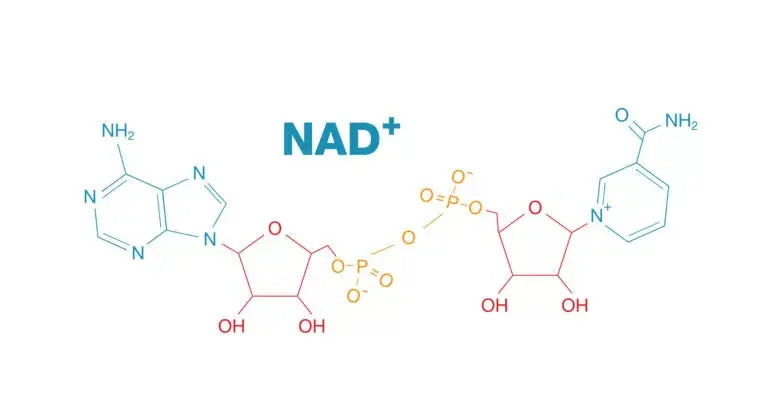
NAD+ and Its Crucial Role in DNA Repair and Genomic Stability
Share
NAD+, a fundamental coenzyme in cellular metabolism, has emerged as a key player in maintaining DNA integrity and genomic stability. Studies show that NAD+ directly supports vital DNA repair mechanisms and influences cellular pathways that guard against genomic instability, a major contributor to ageing and disease. Understanding the central role of NAD+ in these processes provides new insights into cellular health and longevity, with implications extending to anti aging strategies and advanced peptide-based therapies. This article dives deep into how NAD+ orchestrates the DNA repair machinery and safeguards the genome from damage.
The Biochemical Foundations of NAD+ in Cellular Function
Structure and Metabolic Role of NAD+
NAD+ (nicotinamide adenine dinucleotide) is a versatile molecule present in all living cells, existing in oxidized (NAD+) and reduced (NADH) forms. It functions primarily as an electron carrier in metabolic processes such as glycolysis, the tricarboxylic acid (TCA) cycle, and oxidative phosphorylation, crucial for ATP production. Beyond energy metabolism, NAD+ serves as a necessary cofactor for various enzymes involved in post-translational modifications, modulating protein activity that influences cellular responses.
NAD+ Biosynthesis and Cellular Availability
Cells maintain NAD+ pools through three key pathways: the de novo synthesis from tryptophan, the Preiss-Handler pathway starting from nicotinic acid, and the salvage pathway that recycles nicotinamide and its derivatives. The salvage pathway, regulated by the enzyme nicotinamide phosphoribosyltransferase (NAMPT), is especially critical in proliferating cells. Maintaining NAD+ homeostasis is essential, given its consumption by DNA repair enzymes and sirtuins, and imbalances can impair cellular functions.
NAD+ as a Substrate for DNA Repair Enzymes
Role of PARPs in DNA Damage Response
Poly(ADP-ribose) polymerases (PARPs) are a family of enzymes that detect DNA strand breaks and use NAD+ to synthesize ADP-ribose polymers. These polymers recruit and organize DNA repair complexes at the site of damage, facilitating efficient repair. PARP1, the most studied member, plays a pivotal role in base excision repair (BER) and single-strand break repair (SSBR).
Sirtuins and Chromatin Regulation
Sirtuins are NAD+-dependent deacetylase enzymes that influence DNA repair indirectly by modifying chromatin structure and regulating stress responses. By consuming NAD+, they modulate histone acetylation states, allowing DNA repair proteins access to damaged DNA, thus contributing to genomic maintenance.
Mechanisms of NAD+ in DNA Repair and Genomic Stability
NAD+ in Repair Pathway Activation
Research suggests that NAD+ availability is crucial for the activation and sustainability of PARP1 activity at DNA lesions. Adequate NAD+ pools ensure rapid polymer formation, prompting efficient recruitment of DNA repair proteins such as XRCC1, which scaffolds critical repair complexes. Conversely, NAD+ depletion compromises this process, leading to inefficient repair and the accumulation of DNA damage.
Prevention of Replication Stress and DNA Fork Collapse
By supporting repair pathways, NAD+ helps to prevent replication fork stalling—a condition that if unaddressed, causes genome instability through fork collapse and double-strand breaks. This critical function highlights NAD+’s role in supporting DNA replication fidelity.
Implications of NAD+ Depletion on Genomic Integrity
Consequences of NAD+ Deficiency
Lower NAD+ levels, observed during ageing or under pathological stress, are linked to diminished DNA repair efficiency, increased oxidative DNA damage, and chromosomal abnormalities. These genomic insults contribute to the onset of cellular senescence, oncogenesis, and degenerative diseases.
Links to Age-related Genomic Instability
Research on aged cells reveals consistent NAD+ depletion coinciding with chronic DNA damage marker accumulation. This nexus has positioned NAD+ as a critical mediator for age-associated genomic instability, underscoring its role in anti aging research and potential therapeutic interventions.
Anti Aging and NAD+: A Growing Relationship
NAD+ Levels Decline with Age
Studies show that NAD+ levels gradually decrease in organisms as they age, impairing mitochondrial function, DNA repair capacity, and cellular metabolism. These changes accelerate ageing phenotypes and functional decline in tissues.
Potential to Modulate Ageing Pathways
By sustaining NAD+ concentrations, cells maintain genomic stability and metabolic health, factors strongly implicated in delaying ageing. The activation of sirtuins through NAD+ levels also supports cellular longevity programs, making NAD+ central to emerging anti aging strategies.
The Interplay Between NAD+, Peptides, and DNA Repair
Peptides Enhancing NAD+ Functionality
Bioactive peptides are being investigated for their role in enhancing NAD+ metabolism and DNA repair mechanisms. Some peptides may promote the salvage pathways or modulate enzyme activity involved in NAD+ biosynthesis and utilization, thereby supporting genomic stability.
Synergistic Effects in Cellular Maintenance
Research suggests that combining NAD+ supportive pathways with specific peptides might amplify cellular repair capacity and protection against DNA damage, offering enhanced potential for interventions aiming to preserve cellular youth and function.
Exogenous NAD+ and Cellular DNA Repair Effects
Studies on NAD+ Supplementation in DNA Repair
Research suggests that exogenous NAD+ can influence intracellular NAD+ levels directly, thereby supporting PARP activity and DNA repair efficiency. However, the effectiveness varies by cell type and exposure duration, with potential biphasic effects on genomic synthesis processes.
Considerations in NAD+ Precursor Usage
While NAD+ precursors such as nicotinamide riboside (NR) and nicotinamide mononucleotide (NMN) can elevate intracellular NAD+, studies highlight that intact NAD+ may have immediate modulatory effects on mitochondrial activity and DNA repair pathways that precursors do not replicate as rapidly.
For those exploring NAD+ support, formulations aimed at enhancing NAD+ bioavailability show promise in boosting cellular repair capacity and metabolic health without relying on precursor conversion.
Mitochondrial NAD+ and Genomic Stability
Role of Mitochondrial NAD+ Transport
NAD+ localized in mitochondria supports key metabolic reactions that influence cellular energy and DNA repair activities. Recent studies identify transporters like SLC25A51 that regulate mitochondrial NAD+ levels, linking mitochondrial function to nuclear genomic stability.
Impact on Replication and DNA Repair Stress Responses
Disruptions in mitochondrial NAD+ supply can lead to impaired nucleotide biosynthesis, DNA replication stress, and genome instability, emphasizing the coordinated role of NAD+ between cellular compartments in preserving genome integrity.
NAD+ in Cancer and DNA Damage Response
NAD+ Levels Modulating Tumor DNA Repair Capacity
Cancer cells often exhibit altered NAD+ metabolism to sustain rapid DNA repair and proliferation. Elevated NAD+ supports PARP activity and chromatin remodeling, enhancing repair of genotoxic damage and contributing to chemoresistance.
Therapeutic Targeting of NAD+ Pathways
Given NAD+’s role in DNA repair, targeting NAD+ biosynthesis pathways (like NAMPT inhibitors) has been explored as a cancer therapy strategy. However, resistance mechanisms and the tumor environment’s complexity require nuanced approaches to disrupt NAD+-dependent repair effectively.
Practical Insights and Future Directions
Potential of NAD+ Modulation in Anti Aging Therapies
Studies suggest sustaining NAD+ levels through supplementation and lifestyle might promote DNA repair and genomic stability, supporting healthy ageing. Ongoing research continues to refine dosage and delivery methods that maximize these benefits with minimal adverse effects.
Emerging Roles of Peptides and NAD+ Combinations
Integrating peptides that support NAD+ metabolism and DNA repair enzymes could potentiate therapeutic approaches for age-related diseases and genomic maintenance, heralding a new frontier in cellular restoration strategies.
Summary and Call to Action
NAD+ is indispensable for DNA repair and maintaining genomic stability, playing a central role in cellular metabolism, longevity, and anti aging. It acts as a necessary cofactor for repair enzymes such as PARPs and sirtuins, facilitating efficient DNA damage responses and preserving genome integrity. NAD+ depletion, common in ageing and disease, disrupts these processes, linking it closely to genomic instability and cellular dysfunction. Emerging research on peptides and NAD+ metabolism reveals promising avenues to enhance DNA repair and cellular health without invasive interventions. To explore the potential benefits of NAD+ in supporting your cellular and genomic well-being, consider learning more about how targeted NAD+ supplementation could integrate into your anti aging and health optimization strategies.

